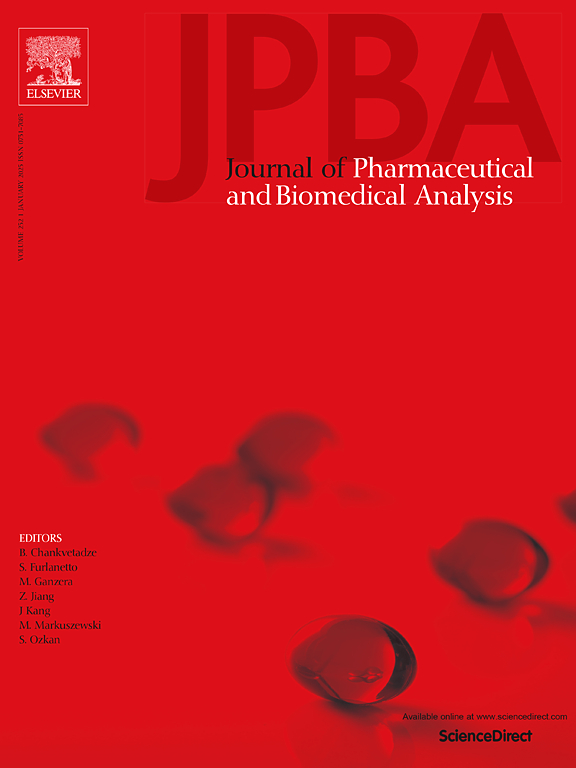高效液相色谱-质谱联用法测定人血浆中游离和脂质体两性霉素B
IF 3.1
3区 医学
Q2 CHEMISTRY, ANALYTICAL
Journal of pharmaceutical and biomedical analysis
Pub Date : 2025-04-10
DOI:10.1016/j.jpba.2025.116884
引用次数: 0
摘要
生物样品中游离和包封药物的有效分离和特异性检测是脂质体药物药动学研究的关键。本研究建立了一种简单、方便、可靠、选择性强的固相萃取分离方法,并结合灵敏的LC-MS/MS技术对人血浆中脂质体两性霉素B (L-AMB)和非脂质体两性霉素B (F-AMB)进行了充分验证。利用Oasis HLB固相萃取筒实现了血浆中L-AMB和F-AMB的同时分离。L-AMB在洗脱液中收集,F-AMB用含有1 %甲酸的甲醇从滤筒中洗脱。色谱柱为ZORBAX Eclise XDB C18(2.1 × 50 mm, 3.5 μm),流动相为甲醇(0.1 %甲酸)和5 mm乙酸铵溶液(0.1 %甲酸),流速为0.5 mL/min,梯度洗脱,分离物和内标物(纳他霉素)。采用多反应监测(MRM)法在正离子模式下电喷雾电离(ESI)界面进行质谱检测。L-AMB的线性范围为200-50000 ng/mL, F-AMB为10.0-1600 ng/mL。采用一系列交叉质控样品验证定量方法的选择性、稳定性和重复性。使用我们的方法,我们在没有相互干扰的情况下定量了F-AMB和L-AMB,并获得了两种分析物的良好的发生样品再分析(ISR)结果。该方法还成功应用于健康志愿者的临床研究。本文章由计算机程序翻译,如有差异,请以英文原文为准。
A convenient and rapid LC-MS/MS method for determination of free and liposomal amphotericin B in human plasma by simultaneous separation using SPE
Effective separation and specific detection of free and encapsulated drugs in bio-samples are critical to the pharmacokinetic investigation of liposomal medicine. In this study, a simple, convenient, reliable, and selective SPE separation method coupled with sensitive LC-MS/MS technique was developed and fully validated for the detection of liposomal amphotericin B (L-AMB) and non-liposomal amphotericin B (F-AMB) in human plasma. The simultaneous separation between L-AMB and F-AMB in plasma were realized using Oasis HLB SPE cartridge. L-AMB was collected in the aqueous eluate and F-AMB was eluted from the cartridge by methanol containing 1 % formic acid. The analyte and internal standard (natamycin) were separated on a ZORBAX Eclise XDB C18 column (2.1 × 50 mm, 3.5 μm) with gradient elution at a flow rate of 0.5 mL/min, employing a mobile phase that consisted of methanol (0.1 % formic acid) and 5 mM ammonium acetate solution (0.1 % formic acid). Mass spectrometry detection was performed in positive ion mode with electrospray ionization (ESI) interface by multiple reaction monitoring (MRM) method. The linearity range was 200–50000 ng/mL for L-AMB and 10.0–1600 ng/mL for F-AMB. A series of cross quality control samples was adopted to verify the selectivity, stability, and reproducibly of the quantification. Using our methodology, we quantified F-AMB and L-AMB without mutual interferences and obtained excellent incurred sample reanalysis (ISR) results for both analytes. The method was also successfully applied to a clinical study in healthy volunteers.
求助全文
通过发布文献求助,成功后即可免费获取论文全文。
去求助
来源期刊
CiteScore
6.70
自引率
5.90%
发文量
588
审稿时长
37 days
期刊介绍:
This journal is an international medium directed towards the needs of academic, clinical, government and industrial analysis by publishing original research reports and critical reviews on pharmaceutical and biomedical analysis. It covers the interdisciplinary aspects of analysis in the pharmaceutical, biomedical and clinical sciences, including developments in analytical methodology, instrumentation, computation and interpretation. Submissions on novel applications focusing on drug purity and stability studies, pharmacokinetics, therapeutic monitoring, metabolic profiling; drug-related aspects of analytical biochemistry and forensic toxicology; quality assurance in the pharmaceutical industry are also welcome.
Studies from areas of well established and poorly selective methods, such as UV-VIS spectrophotometry (including derivative and multi-wavelength measurements), basic electroanalytical (potentiometric, polarographic and voltammetric) methods, fluorimetry, flow-injection analysis, etc. are accepted for publication in exceptional cases only, if a unique and substantial advantage over presently known systems is demonstrated. The same applies to the assay of simple drug formulations by any kind of methods and the determination of drugs in biological samples based merely on spiked samples. Drug purity/stability studies should contain information on the structure elucidation of the impurities/degradants.

 求助内容:
求助内容: 应助结果提醒方式:
应助结果提醒方式:


